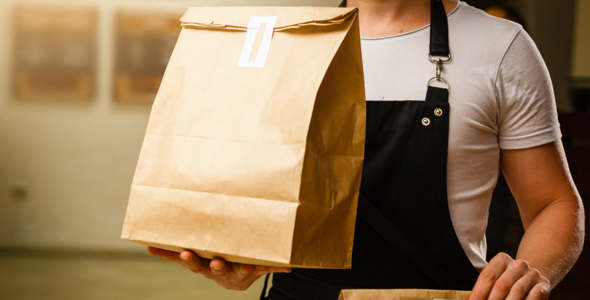By the bioMérieux Connection Editors
With many cities under shelter-in-place orders, and others with advisories to stay at home, people are stocking up on groceries and placing orders for pickup or delivery. Minimizing contact with others through social distancing is crucial to flatten the curve and reduce the rate of coronavirus infection. However, many people are wondering if it’s still possible to transmit the virus via food and pickup or delivery services.
Has Anyone Gotten COVID-19 from Food?
As of this writing on March 23, 2020, neither the FDA (Food and Drug Administration) nor EFEA (European Food Safety Authority) have reported food as a source or route of transmission for this virus.
Is it Possible for the Virus to Get on Your Food or Food Packaging?
It is possible that the virus could get on food or food packaging from an airborne droplet following a sneeze or cough, or from someone’s contaminated hands. However, food has not been reported as a source or route of virus transmission.
How Long Can the Virus Survive on Food or Food Packaging?
Virus survival time varies widely and depends on a variety of factors, such as surface type, temperature, and humidity. In general, it appears that viruses survive for longer periods on non-porous surfaces, such as plastic, and less time on porous surfaces, such as cardboard. Regardless of virus survival time, it is important to take precautions.
Is it Safe to Order Takeout or Delivery?
Restaurants are held to both federal and state standards when it comes to food safety. Since the main risk factor is being near other people, ordering food for takeout or delivery can be a good way to help minimize contact with others. That said, it’s a good idea to treat anything coming into your home from the outside with caution and take appropriate hygiene steps.
What Precautions Can You Take with Food and Food Packaging?
With food, continue to take normal food safety precautions, such as ensuring that meat reaches the proper temperature for the appropriate amount of time. No published data exists yet on what temperatures kill SARS-CoV-2, but the virus that caused the SARS outbreak in 2003, and which is similar to SARS-CoV-2, is killed at temperatures around 140 degrees Fahrenheit maintained for 15 minutes. Higher temperatures killed the SARS virus in a shorter amount of time. Because the viruses are similar, it is likely that heating food up to those temperatures would also kill SARS-CoV-2.
Although there have not been any reported cases of COVID-19 from food sources, out of an abundance of caution, individuals who are immunocompromised may consider avoiding raw foods, such as salads, that do not involve a heating “kill step.”
Additionally, everyone should keep in mind food shelf-life, expiration, and proper storage. Buying large quantities of food, which then go bad or that are stored improperly, is a recipe for getting sick from foodborne illnesses, such as Salmonella and E. coli. Keep in mind that while grocery stores may temporarily have low stock, the FDA is monitoring the situation closely and has not reported any widespread disruptions to the food supply chain.
For food packaging, it is advisable to disinfect surfaces, such as cardboard boxes, jars, and cans. Make sure to practice good sanitation, including washing your hands thoroughly and regularly (including before and after handling food and packaging), disinfecting counters, cabinets and drawer pulls, door handles, and other high-contact surfaces.
Opinions expressed in this article are not necessarily those of bioMérieux, Inc.



